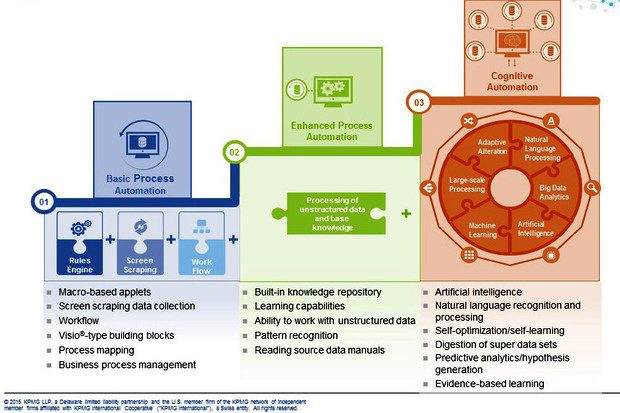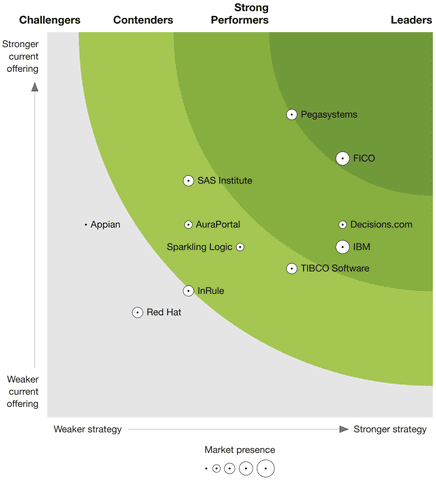Summary: Digital Decisioning Platforms is a new segment identified by Forrester that marries Business Process Automation, Business Rules Management, and Advanced Analytics. For platform developers it’s a new way to slice the market. For users it eases integration of predictive models into the production environment.
 As analytic platform vendors and the many startups in advanced analytics & AI have approached the market there have been primarily three models.
As analytic platform vendors and the many startups in advanced analytics & AI have approached the market there have been primarily three models.
- Provide a general purpose analytic platform. (e.g. SAS, IBM, Alteryx, Rapidminer)
- Create an analytics platform for a targeted enterprise-wide process across many industries. (e.g. sales:Einstein, marketing B2B: Radius, HR: Stella, legal: Everlaw, etc.)
- Focus on the analytics needs of a single vertical industry and typically a single vertical process (advertising: dataxu, real estate: Redfin, agriculture: BlueRiver).
In each case, the vendor is seeking to maximize their market reach in some defensible manner. In terms of what is most popular, or at least most talked about, the third represents the currently hot ‘Vertical Strategy’ most favored by VCs for AI-first startups.
A New 4th Business Model for Analytics
Now Forrester is claiming to have spotted a 4th emerging new model that they are labeling ‘Digital Decisioning Platforms’ in their first and most current Q4 2018 review (find a copy here).
This interesting new segment seeks to be a general purpose platform across all enterprises that marries three existing capabilities:
- Business Process Automation
- Business Rules Management
- Advanced Analytics

Digital Decisioning, or Cognitive Automation as KPMG prefers to call it in the graphic above is a rapidly expanding category.
You might argue that several existing platforms for example in the CRM and Marketing or Advertising space also combine these features, but the key here is that these digital Decisioning platforms must be widely applicable across many use cases within an enterprise.
Use cases can undoubtedly be found in many places ranging from HR to accounting, to supply chain management. However the most prevalent cases are likely to involve enhancing customer interaction in both an optimum and consistent fashion.
According to a separate Forrester report, “A key challenge of digital business is deciding what to do in the customer’s moment of need – and then doing it. Digital Decisioning software capitalizes on analytical insights and machine learning models about customers and business operations to automate actions…for individual customers through the right channel.”
Competitors
Forrester identified and reviewed 11 vendors using its ‘New Wave’ format reserved for situations in which the segment is new and in-depth user reviews aren’t judged possible. This is an eclectic group of providers including some well-known analytic platform vendors, but including others from the BPA and business rules automation side of the tracks. 
Recognizing that the segment is new, Forrester and many of the user reviewers find that many of these offerings have major shortcomings in one or more areas.
While BPA and business rules automation are surely of interest to their users, I was most interested to focus on how well predictive analytics had been integrated into the package. Of the ten criteria used by Forrester in its review, two relate specifically to this issue.
- Analytic Features: Which data analysis features are built into the platform and how well do they work.
- Functional Integration: What integration features does the product provide to create and consume externally created and hosted decision models.
The results on these two criteria are relatively easy to predict. The vendors we know from the data science space, FICO, IBM, TIBCO, and SAS all score well on Analytic Features while other do not. However, in this group only SAS scores high on the ability to utilize external models.
My take is that this has to do more with growing pains in a new platform and not an intentional oversight. I expect this will be a focus feature in coming releases.
What Do the Users Say – and Who Are They
Keeping in mind that there are only a few reviewers for each platform two sets of comments stood out to me.
No-code was mentioned as a specific appreciated feature but only appeared in 3 of the 11 reviews. It’s not clear if any of the other 8 providers offer a no-code developer environment.
Long learning curve was called out by several reviewers. Probably to be expected in a new category offering with few prior users.
Trying to read between the lines, it’s evident that the data science team is not the primary user. It appears that these platforms are designed to be used primarily by teams combined of application designer/developers and business analysts focused on process improvement.
What about the Data Science
There’s also no mention of any automation of the model creation, nor frankly did I expect to find one. It appears that the internal data science team continues to have a key role in the creation and maintenance of the embedded analytics.
In this regard, the ability of the platform to intake previously designed predictive models from different platforms may be as important as the ability to build models natively within the platform.
My guess is that this will appeal most to companies already on their Business Process Automation journey. The challenge that these users have had so far is the common one in data science. That is, how to implement predictive analytic models within the business process so that the end user finds the result easy and seamless.
This marriage of BPA and advanced analytics seems like a natural and logical extension. The challenge is that this is still a custom development platform and not the tightly focused ‘full stack’ solution offered by ‘vertical strategy’ developers.
Not that these ‘full stack’ solutions are plug-and-play. All of these require custom developed and maintained predictive models. If your developer group values a single platform to use across many applications in your business, you’ll want to give these a look.
Other articles by Bill Vorhies.
About the author: Bill Vorhies is Editorial Director for Data Science Central and has practiced as a data scientist since 2001. He can be reached at:
[email protected] or [email protected]
